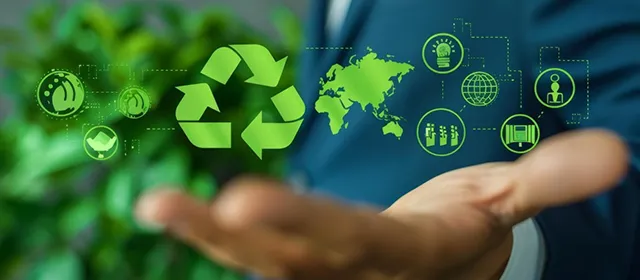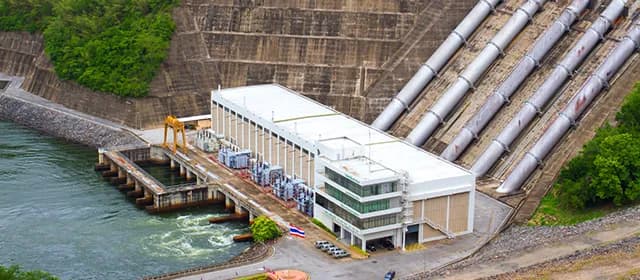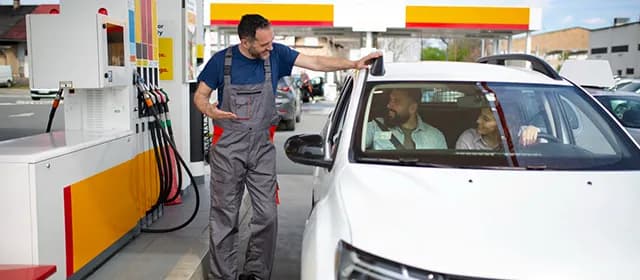The linear “take-make-dispose” model of industrial production has become increasingly unsustainable. Resource depletion, rising costs, and stricter environmental regulations are forcing industries to rethink supply chains and production processes. The circular economy, a regenerative model that keeps materials in use for as long as possible, offers a viable solution. Kings Research estimates that the global circular economy market will generate a whopping $2,882.11 billion by 2031.
According to some reports, implementing circular economy strategies in the EU could generate over €1.8 trillion ($1.944 trillion) in economic benefits by 2030 while reducing greenhouse gas emissions significantly compared to the current linear model (Source: https://worldgbc.org/).
For industrialists, this represents not only environmental stewardship but also a strategic opportunity to unlock value, enhance competitiveness, and future-proof operations.
A Strategic Lens: How Circular Economy Shapes Industrial Competitiveness
For industries, implementing a circular economy framework involves a strategic shift that goes beyond waste management. Design thinking, lifecycle management, and resource efficiency are all included in fundamental operations through circularity. Businesses can utilize this strategy to optimize production processes, lessen their reliance on raw materials, and create new revenue streams from recycled or reused materials.
From a competitive standpoint, industries adopting circular models can gain a first-mover advantage. The World Economic Forum estimates that a shift to a circular economy could create $4.5 trillion in economic opportunities globally by 2030 (Source: https://www.weforum.org/).
How Circular Economy Transforms Supply Chains
Circular economy principles demand a rethinking of traditional supply chains. Instead of viewing waste as an inevitable byproduct, industries treat materials as reusable resources, designing products for durability, reparability, and recyclability. This shift requires integrating reverse logistics, refurbishment processes, and remanufacturing into supply chain design.
For example, in the automotive industry, manufacturers are incorporating recycled metals and battery materials into new vehicles. This reduces dependency on virgin resources while lowering costs and improving sustainability credentials. By 2025, the EU manufacturing industry may save up to $630 billion annually on net materials costs, according to the Ellen MacArthur Foundation (Source: https://www.ellenmacarthurfoundation.org/).
Where Industries Are Driving the Circular Economy
Circular economy adoption varies by region and sector. Europe is leading on policy-driven circularity with the European Commission’s Circular Economy Action Plan to make all packaging reusable or recyclable by 2030.
The automotive, electronics, and construction industries are the most active in circular initiatives. For example, Philips has product-as-a-service models for healthcare equipment, enabling repair, refurbishment, and material recovery, and reducing waste.
In Asia, China has circular economy principles in its national development strategy to reduce resource consumption and increase recycling rates. This has led to investments in recycling infrastructure and industrial symbiosis projects.
Who Benefits Most From Circular Economy?
While the benefits of the circular economy apply to society as a whole, some sectors benefit more than others. Resource-intensive industries like manufacturing, construction, and energy benefit from lower raw material costs and supply chain resilience. Consumer goods companies can increase brand value by being part of the sustainability trend and attract environmentally conscious customers.
From a corporate governance perspective, circular economy practices improve regulatory compliance, reduce environmental risks, and strengthen stakeholder relationships. So circularity is a long-term value creation strategy.
What Are the Barriers to Scaling Circular Economy?
Going circular is not without challenges. Industrial transition requires significant changes to design processes, production systems, and business models. Technical hurdles are developing recycling technologies, designing products for disassembly, and creating closed-loop supply chains.
Economic barriers exist, too. Circular processes require upfront investments in new machinery, logistics systems, and skills training. Without regulatory incentives or cost-sharing mechanisms, the business case for circular transformation can be tough for some companies.
And policy fragmentation across regions can make it difficult to scale circular models globally. Standardizing regulations and industry-wide collaboration will be key to overcoming these barriers.
How Policy Is Accelerating Circular Economy Adoption
Government policy plays a vital role in driving circular economy adoption. The European Union’s Circular Economy Action Plan offers regulatory frameworks, incentives, and funding for industries adopting circular practices. This includes extended producer responsibility schemes, waste reduction targets, and mandatory eco-design requirements.
China’s 14th Five-Year Plan incorporates circular economy targets, focusing on resource efficiency and industrial recycling infrastructure. In the United States, certain states, such as California, have introduced circular economy initiatives targeting plastics, electronics, and construction waste.
These policy moves are shaping industrial strategies, prompting businesses to integrate circular thinking into core operations.
When Will Circular Economy Become a Norm for Industry?
The shift toward circular economy models is already underway, but full-scale adoption will take time. According to the Ellen MacArthur Foundation, achieving a global circular economy transition could take until 2050, requiring coordinated efforts from governments, industries, and consumers.
However, industries that begin integrating circular economy principles today, through product redesign, resource efficiency, and closed-loop supply chains, will position themselves as leaders in the future economy. Early adoption can deliver a competitive advantage, improved sustainability metrics, and stronger stakeholder engagement.
The Netherlands’ Circular Economy Roadmap
The Netherlands has emerged as a global leader in circular economy adoption, guided by its national Circular Economy Program. The roadmap aims to achieve a fully circular economy by 2050, with intermediate targets for 2030 focusing on key sectors such as construction, plastics, and manufacturing.
A notable project under this program is the “Circular Construction Hub,” which promotes recycling and reuse of building materials across the construction sector. This initiative has reduced construction waste in participating projects, proving the potential of circular approaches to deliver economic and environmental benefits. (Source: https://www.zerowastescotland.org.uk/)
This case study demonstrates that with clear policy frameworks, industry collaboration, and technological innovation, circular economy principles can be successfully embedded at scale.
To Wrap Up
For enterprises looking for resilience, sustainability, and a competitive edge, the circular economy is now a strategic necessity rather than a far-off idea. Industrialists can turn obstacles into opportunities by rethinking supply chains, making the most use of resources, and designing for durability.
The circular economy will emerge as a key component of industrial strategy when market demand, technological advancement, and governmental regulation come together. Adopting circularity now is about leading the shift to a more profitable and sustainable industrial future, not merely about complying with regulations.




